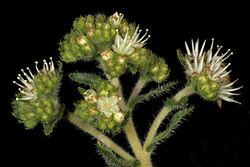Biology:Lobostemon capitatus
| Lobostemon capitatus | |
|---|---|

| |
| Scientific classification | |
| Kingdom: | Plantae |
| Clade: | Tracheophytes |
| Clade: | Angiosperms |
| Clade: | Eudicots |
| Clade: | Asterids |
| Order: | Boraginales |
| Family: | Boraginaceae |
| Genus: | Lobostemon |
| Species: | L. capitatus
|
| Binomial name | |
| Lobostemon capitatus (L.) H.Buek
| |
| Synonyms[1] | |
| |
Lobostemon capitatus is a species belonging to the forget-me-not family. It is endemic to the Western Cape of South Africa, where it is found between Porterville and Bredasdorp.
Description
Lobostemon capitatus is a shrub that grows 30–60 cm (0.98–1.97 ft) tall, sometimes reaching a height of up to 80 cm (2.6 ft).[2][3] The branches are more or less equally spaced and the herbaceous branches are hairy.[3] The leaves are slender, tapering to a point.[2] The undersides of the leaves are covered in hairs. The upper face is hairless or has only a few sparse hairs.[3] The flowers are cream with purple markings.[2] They are small, reaching a length of about 7 mm (0.28 in).They grow as a capitate cyme, meaning that large number of sessile flowers grow from a suppressed rachis. The flower buds arranged in two distinct parallel rows and don't spreading much in fruiting stage.[3] The stamens protrude past the petals in adult flowers. They are typically all of similar length, although one may be shorter than the others.[3] The staminal scales are well developed. They are triangular with lateral lobes.[2] They occur at the throat of the corolla tube, 2–3 mm (0.079–0.118 in) above the base. The area between them is hairy.[3]
Distribution and habitat
This species is endemic to the Western Cape of South Africa, where it is found between Porterville and Bredasdorp where it occurs on shale slopes and flats. It primarily occurs in Renosterveld in the northern parts of its distribution and in Elim Ferricrete Fynbos towards the south east.[3] It is known from fifteen fragmented subpopulations.[4]
Conservation
The South African National Biodiversity Institute (SANBI) has classified Lobostemon capitatus as vulnerable. The small populations continue to decline, largely due to agriculture and urban development, especially in the Durbanville area.[4]
References
- ↑ |id= 4060313 |taxon=Lobostemon capitatus |accessdate=11 August 2021
- ↑ 2.0 2.1 2.2 2.3 Manning, John; Goldblatt, Peter (2012). Plants of the Greater Cape Floristic Region : 1: the core Cape flora. Pretoria: South African National Biodiversity Institute, SANBI. ISBN 978-1-919976-74-7. OCLC 852384288. https://www.sanbi.org/sites/default/files/documents/documents/strelitzia-29-2012.pdf.
- ↑ 3.0 3.1 3.2 3.3 3.4 3.5 3.6 BODATSA: Botanical Collections. v1.4. South African National Biodiversity Institute. Dataset/Occurrence. http://ipt.sanbi.org.za/iptsanbi/resource?r=brahms_online&v=1.4
- ↑ 4.0 4.1 Buys, M.H., Helme, N.A. & Raimondo, D. 2006. Lobostemon capitatus (L.) H.Buek. National Assessment: Red List of South African Plants version 2020.1. Accessed on 2021/08/11
Wikidata ☰ Q15590446 entry
 |

